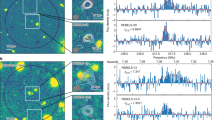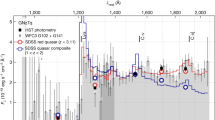Abstract
Interstellar dust plays a crucial role in the evolution of the Universe by assisting the formation of molecules1, by triggering the formation of the first low-mass stars2, and by absorbing stellar ultraviolet–optical light and subsequently re-emitting it at infrared/millimetre wavelengths. Dust is thought to be produced predominantly in the envelopes of evolved (age >1 Gyr), low-mass stars3. This picture has, however, recently been brought into question by the discovery of large masses of dust in the host galaxies of quasars4,5 at redshift z > 6, when the age of the Universe was less than 1 Gyr. Theoretical studies6,7,8, corroborated by observations of nearby supernova remnants9,10,11, have suggested that supernovae provide a fast and efficient dust formation environment in the early Universe. Here we report infrared observations of a quasar at redshift 6.2, which are used to obtain directly its dust extinction curve. We then show that such a curve is in excellent agreement with supernova dust models. This result demonstrates a supernova origin for dust in this high-redshift quasar, from which we infer that most of the dust at high redshifts probably has the same origin.
This is a preview of subscription content, access via your institution
Access options
Subscribe to this journal
Receive 51 print issues and online access
$199.00 per year
only $3.90 per issue
Buy this article
- Purchase on Springer Link
- Instant access to full article PDF
Prices may be subject to local taxes which are calculated during checkout


Similar content being viewed by others
References
Hirashita, H. & Ferrara, A. Effects of dust grains on early galaxy evolution. Mon. Not. R. Astron. Soc. 337, 921–937 (2002)
Schneider, R., Ferrara, A., Salvaterra, R., Omukai, K. & Bromm, V. Low-mass relics of early star formation. Nature 422, 869–871 (2003)
Whittet, D. C. B. Dust in the Galactic Environment (Series in Astronomy & Astrophysics, Institute of Physics (IOP) Publishing, Bristol, 2003)
Bertoldi, F. et al. Dust emission from the most distant quasars. Astron. Astrophys. 406, L55–L58 (2003)
Priddey, R. S., Isaak, K. G., McMahon, R. G., Robson, E. I. & Pearson, C. P. Quasars as probes of the submillimetre cosmos at z > 5. I. Preliminary SCUBA photometry. Mon. Not. R. Astron. Soc. 344, L74–L78 (2003)
Todini, P. & Ferrara, A. Dust formation in primordial Type II supernovae. Mon. Not. R. Astron. Soc. 325, 726–736 (2001)
Nozawa, T., Kozasa, T., Umeda, H., Maeda, K. & Nomoto, K. Dust in the early Universe: dust formation in the ejecta of population III supernovae. Astrophys. J. 598, 785–803 (2003)
Schneider, R., Ferrara, A. & Salvaterra, R. Dust formation in very massive primordial supernovae. Mon. Not. R. Astron. Soc. 351, 1379–1386 (2004)
Moseley, S. H., Dwek, E., Glaccum, W., Graham, J. R. & Lowenstein, R. F. Far-infrared observations of thermal dust emission from supernova 1987A. Nature 340, 697–699 (1989)
Dunne, L., Eales, S., Ivison, R., Morgan, H. & Edmunds, M. Type II supernovae as a significant source of interstellar dust. Nature 424, 285–287 (2003)
Morgan, H. L., Dunne, L., Eales, S. A., Ivison, R. J. & Edmunds, M. G. Cold dust in Kepler's supernova remnant. Astrophys. J. 597, L33–L36 (2003)
Richards, G. T. et al. Red and reddened quasars in the Sloan Digital Sky Survey. Astron. J. 126, 1131–1147 (2003)
Reichard, T. A. et al. Continuum and emission-line properties of broad absorption line quasars. Astron. J. 126, 2594–2607 (2003)
Hopkins, P. et al. Astrophys. J. (in the press); preprint at 〈http://arXiv.org/astro-ph/0406293〉 (2004).
Gaskell, C. M., Goosmann, R. W., Antonucci, R. R. J. & Whysong, D. H. The nuclear reddening curve for active galactic nuclei and the shape of the infra-red to X-ray spectral energy distribution. Astrophys. J. (submitted); preprint at 〈http://arXiv.org/astro-ph/0309595〉 (2003).
Maiolino, R. et al. Dust in active nuclei. I. Evidence for “anomalous” properties. Astron. Astrophys. 365, 28–36 (2001)
Maiolino, R. et al. Extreme gas properties in the most distant quasars. Astron. Astrophys. 420, 889–897 (2004)
Baffa, C. et al. NICS: The TNG Near Infrared Camera Spectrometer. Astron. Astrophys. 378, 722–728 (2001)
Maiolino, R., Juarez, Y., Mujica, R., Nagar, N. & Oliva, E. Early star formation traced by the highest-redshift quasars. Astrophys. J. 596, L155–L158 (2003)
Hirashita, H., Hunt, L. K. & Ferrara, A. Dust and hydrogen molecules in the extremely metal-poor dwarf galaxy SBS 0335-052. Mon. Not. R. Astron. Soc. 330, L19–L23 (2002)
Woosley, S. E. & Weaver, T. A. The evolution and explosion of massive stars. II. Explosive hydrodynamics and nucleosynthesis. Astrophys. J. Suppl. 101, 181–235 (1995)
Larson, R. B. Early star formation and the evolution of the stellar initial mass function in galaxies. Mon. Not. R. Astron. Soc. 301, 569–581 (1998)
Zubko, V. G., Mennella, V., Colangeli, L. & Bussoletti, E. Optical constants of cosmic carbon analogue grains. I. Simulation of clustering by a modified continuous distribution of ellipsoids. Mon. Not. R. Astron. Soc. 282, 1321–1329 (1996)
Scott, A. & Duley, W. W. Ultraviolet and infrared refractive indices of amorphous silicates. Astrophys. J. Suppl. 105, 401–405 (1996)
Mukai, T. in Evolution of Interstellar Dust and Related Topics (eds Bonetti, A., Greenberg, J. M. & Aiello, S.) 397–446 (Elsevier Science, New York, 1989)
Acknowledgements
All authors have contributed equally to this paper. We thank J. Brucato for providing the optical constant of ACAR grains and we thank M. Walmsley for comments. This work was partially supported by the Italian Ministry of Research (MIUR) and by the National Institute for Astrophysics (INAF).
Author information
Authors and Affiliations
Corresponding author
Ethics declarations
Competing interests
The authors declare that they have no competing financial interests.
Rights and permissions
About this article
Cite this article
Maiolino, R., Schneider, R., Oliva, E. et al. A supernova origin for dust in a high-redshift quasar. Nature 431, 533–535 (2004). https://doi.org/10.1038/nature02930
Received:
Accepted:
Issue Date:
DOI: https://doi.org/10.1038/nature02930
This article is cited by
-
Cool outflows in galaxies and their implications
The Astronomy and Astrophysics Review (2020)
-
Dust in Supernovae and Supernova Remnants I: Formation Scenarios
Space Science Reviews (2018)
-
Planets in the early Universe
Astrophysics and Space Science (2013)
-
Dust in the IGM: pro and contra
Astrophysics and Space Science (2011)
-
Production of dust by massive stars at high redshift
The Astronomy and Astrophysics Review (2011)
Comments
By submitting a comment you agree to abide by our Terms and Community Guidelines. If you find something abusive or that does not comply with our terms or guidelines please flag it as inappropriate.



